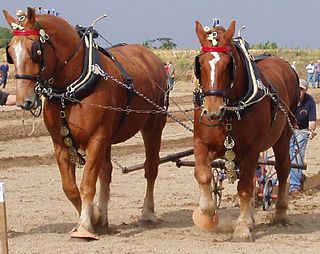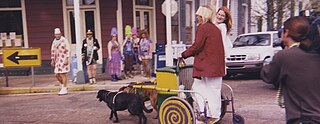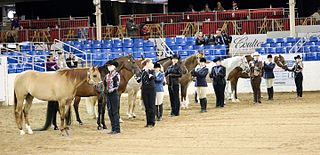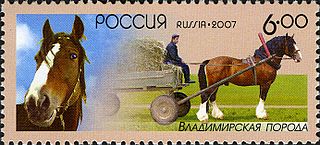
A draft horse (US), draught horse (UK) or dray horse, less often called a carthorse, work horse or heavy horse, is a large horse bred to be a working animal doing hard tasks such as plowing and other farm labor. There are a number of breeds, with varying characteristics, but all share common traits of strength, patience, and a docile temperament which made them indispensable to generations of pre-industrial farmers.

The Clydesdale is a Scottish breed of draught horse. It is named for its area of origin, the Clydesdale or valley of the River Clyde, much of which is within the county of Lanarkshire.

The Percheron is a breed of draft horse that originated in the Huisne river valley in western France, part of the former Perche province from which the breed takes its name. Usually gray or black in color, Percherons are well muscled, and known for their intelligence and willingness to work. Although their exact origins are unknown, the ancestors of the breed were present in the valley by the 17th century. They were originally bred for use as war horses. Over time, they began to be used for pulling stagecoaches and later for agriculture and hauling heavy goods. In the late 18th and early 19th centuries, Arabian blood was added to the breed. Exports of Percherons from France rose exponentially in the late 19th century, and the first purely Percheron stud book was created in France in 1893.

A horse show is a judged exhibition of horses and ponies. Many different horse breeds and equestrian disciplines hold competitions worldwide, from local to the international levels. Most horse shows run from one to three days, sometimes longer for major, all-breed events or national and international championships in a given discipline or breed. Most shows consist of a series of different performances, called classes, wherein a group of horses with similar training or characteristics compete against one another for awards and, often, prize money.

The Suffolk Horse, also historically known as the Suffolk Punch or Suffolk Sorrel, is an English breed of draught horse. The first part of the name is from the county of Suffolk in East Anglia, and the word "Punch" is an old English word for a short stout person. It is a heavy draught horse which is always chestnut in colour, traditionally spelled "chesnut". Suffolk Punches are known as good doers, and tend to have energetic gaits.

Carting is a dog sport or activity in which a dog pulls a dogcart filled with supplies, such as farm goods, camping equipment, groceries or firewood, but sometimes pulling people. Carting as a sport is also known as dryland mushing and is practiced all around the world, often to keep winter sled dogs in competition form during the off-season.

The Hackney pony is a breed of pony closely related to the Hackney horse. Originally bred to pull carriages, they are used today primarily as show ponies. The breed does not have its own stud book, but shares one with the Hackney horse in all countries that have an official Hackney Stud Book Registry.

The Irish Draught horse is the national horse breed of Ireland which developed primarily for farm use. Today, they are especially popular for crossing with Thoroughbreds and warmbloods, producing the popular Irish Sport Horses which excel at the highest levels of eventing and show jumping.

Showmanship is an event found at many horse shows. The class is also sometimes called "Fitting and Showmanship", "Showmanship In-Hand", "Showmanship at Halter" or "Halter Showmanship" It involves a person on the ground leading a horse, wearing a halter or bridle, through a series of maneuvers called a pattern. The horse itself is not judged on its conformation. Exhibitors are judged on exhibiting the animal to its best advantage, with additional scoring for the grooming and presentation of both horse and handler.

The Lithuanian Heavy Draught is a draught horse breed created in Lithuania during the 19th and 20th centuries. They are used mainly for heavy draught and farm work, as well as meat production and the improvement of other breeds. The breed is currently near extinction..

Halter is a type of horse show class where horses are shown "in hand," meaning that they are led, not ridden, and are judged on their conformation and suitability as breeding stock. Depending on breed and geographic region, such events may be called "Halter," "In-Hand," "Breeding," "Model," or "Conformation" classes.

The Vladimir Heavy Draft is a Russian breed of heavy draught horse. It was bred in the early twentieth century in farms and collectives in Ivanovo Oblast and Vladimir Oblast, to the east of Moscow. The most important influence on the development of the breed was from three Clydesdale stallions foaled between 1910 and 1923. The Vladimir was officially recognised in 1946.

Driving, when applied to horses, ponies, mules, or donkeys, is a broad term for hitching equines to a wagon, carriage, cart, sleigh, or other horse-drawn vehicle by means of a harness and working them in this way. It encompasses a wide range of activities from pleasure driving, to harness racing, to farm work, horse shows, and even international combined driving.

Roadster is a type of driving competition for horses and ponies where the horse and exhibitor appear in equipment similar to that used in harness racing. It is derived from the historical use of certain horses hitched to light carts that traveled quickly from one place to another, often racing on ordinary dirt roads, hence the name. The term is also used to describe the horse used for such competition. Horses pull a light sulky and drivers wear racing silks. However, the exhibitors do not race. Instead, they perform in an arena at horse shows at trotting gaits that include a slow jog, a medium speed "road gait," and a rapid and long-strided but controlled trot referred to as showing "at speed." Animals are evaluated on performance and manners.

Pleasure driving is a horse show class seen in the United States, which features light breeds of horses and ponies hitched to a two or four-wheeled show cart. Horses are driven at a walk and two speeds of trot, generally designated as a working or regular trot and an extended "strong" trot. Many horse breeds compete in Pleasure driving. Most classes are judged on the horse's manners, performance, quality and conformation.

The Budweiser Clydesdales are a group of Clydesdale horses used for promotions and commercials by the Anheuser-Busch Brewing Company. There are several "hitches" or teams of horses, that travel around the United States and other countries that remain in their official homes at the company headquarters at the Anheuser-Busch brewery complex in St. Louis, Missouri, or at Merrimack, New Hampshire. At St. Louis, they are housed in a historic brick and stained-glass stable built in 1885. There are eight horses driven at any one time, but ten horses are on each team to provide alternates for the hitch when needed. Assorted Clydesdales are also used as animal actors in television commercials for Budweiser beer, particularly in Super Bowl ads.

The Australian Draught is a hardy Australian breed of draught horse, noted for its strength and a good temperament.

This is a basic glossary of equestrian terms that includes both technical terminology and jargon developed over the centuries for horses and other equidae, as well as various horse-related concepts. Where noted, some terms are used only in American English (US), only in British English (UK), or are regional to a particular part of the world, such as Australia (AU).
Georgian Grande Horse is a new horse breed being developed from crossbreeding the American Saddlebred with the Friesian horse and assorted draft horse breeds. The aim of the breeding is to create a Saddlebred-like horse that adds the best qualities of heavier breeds. One goal of the breed registry is to recreate a historic type of Saddlebred which was common prior to the 20th century, but that has been less emphasized in modern times.

The Norman Cob or Cob Normand is a breed of light draught horse that originated in the region of Normandy in northern France. It is of medium size, with a range of heights and weights, due to selective breeding for a wide range of uses. Its conformation is similar to a robust Thoroughbred, and it more closely resembles a Thoroughbred cross than other French draught breeds. The breed is known for its lively, long-striding trot. Common colours include chestnut, bay and seal brown. There are three general subsets within the breed: horses used under saddle, those used in harness, and those destined for meat production. It is popular for recreational and competitive driving, representing France internationally in the latter, and is also used for several riding disciplines.





















